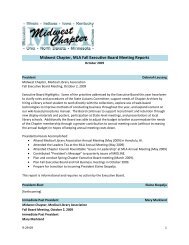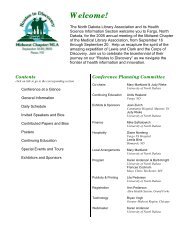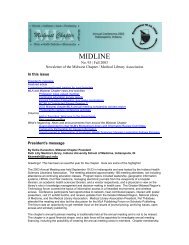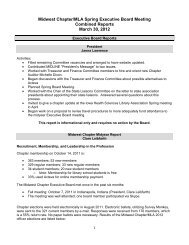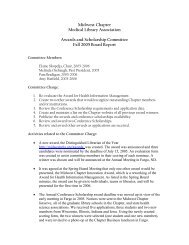full conference program - Midwest Chapter MLA
full conference program - Midwest Chapter MLA
full conference program - Midwest Chapter MLA
You also want an ePaper? Increase the reach of your titles
YUMPU automatically turns print PDFs into web optimized ePapers that Google loves.
Sunday, October 7 th , Session 4<br />
4:05-4:20 McDonnell Suite<br />
The Significance of Disambiguated Authors in an Institutional Publication Database<br />
Authors: Mark Wentz, Melissa L. Rethlefsen, AHIP, Mayo Clinic Libraries, Rochester, Minnesota<br />
Objective: To find the most significant searching strategies of an institutional database in order to better serve Mayo<br />
Clinic employees<br />
Methodology: The Mayo Authors database is a database tracking the scholarly publications of Mayo Clinic doctors since<br />
1871. In the last 15 years, Mayo Authors expanded to include nurses and all other employees. In the last few years, it<br />
was again expanded to include students. We had rebuilt the database web interface in 2010 using anecdotal evidence<br />
of what the users commonly wanted from other databases. However, we did not survey the organization to learn what<br />
they wanted. The database is populated mostly by data mined from several national databases. Mayo Authors provides<br />
added value with a disambiguated authors field (DAF) made up by the authors’ surnames, initials, specialty fields, and<br />
locations (Mayo Clinic has employees in several states). We took the search information from a log of 1.5 years of<br />
searches to find the most common searches used and the most common information wanted by users. We were able to<br />
quantify some search commands and some search strategies used to come up with the single most desired information<br />
sought.<br />
Results: Sifting through the search data, we found that a majority of the searches were of the disambiguated authors<br />
field. Along with that, many of the other searches led directly to a search of the disambiguated authors field.<br />
Conclusions: The popular desired search of the Mayo Authors database hinges greatly on having a disambiguated<br />
authors field. Even though cutting that field would reduce the database maintenance hours by approximately 90%,<br />
without the DAF the users would be unsatisfied with the results.<br />
4:20-4:35 McDonnell Suite<br />
Patient Education Across the Continuum of care.<br />
Author: Ruti Volk MSI, AHIP, University of Michigan Health System, Patient Education Librarian<br />
Objectives: Patient education at the University of Michigan Health System was not centralized. This led to wide<br />
variations in quality, duplication of efforts and outdated materials. The organization needed a solution to facilitate<br />
access to all patient-education materials created and used by clinicians in the system. The goals were to increase<br />
resource sharing and improve the quality and currency of materials.<br />
Methods: A web-based database called “The Patient Education Clearinghouse” was created with Sitemaker, an Open<br />
Source website creation and management application. The Clearinghouse provides a single access point to all patient<br />
education materials used across the system as well as customized sections that fit the workflow of clinicians in specific<br />
areas. The system includes a submission, review and approval process to ensure that only materials that meet specific<br />
quality guidelines are included. Materials in the database are also linked to the Electronic Medical Record so they are<br />
easily accessible to ambulatory-care clinicians and their utilization can be counted for meaningful-use purposes. The<br />
same materials link to inpatient area intranets, and to the institution’s public website, where they are available for<br />
patients at home.<br />
Results and conclusions: Improved access to patient education materials facilitates resource- sharing between<br />
departments and eliminated duplication of effort. Quality has improved because all materials in the clearinghouse are<br />
reviewed and approved by specialists and must comply with quality guidelines. This central repository enables<br />
consistency of patient education across the continuum of care and all care settings.



